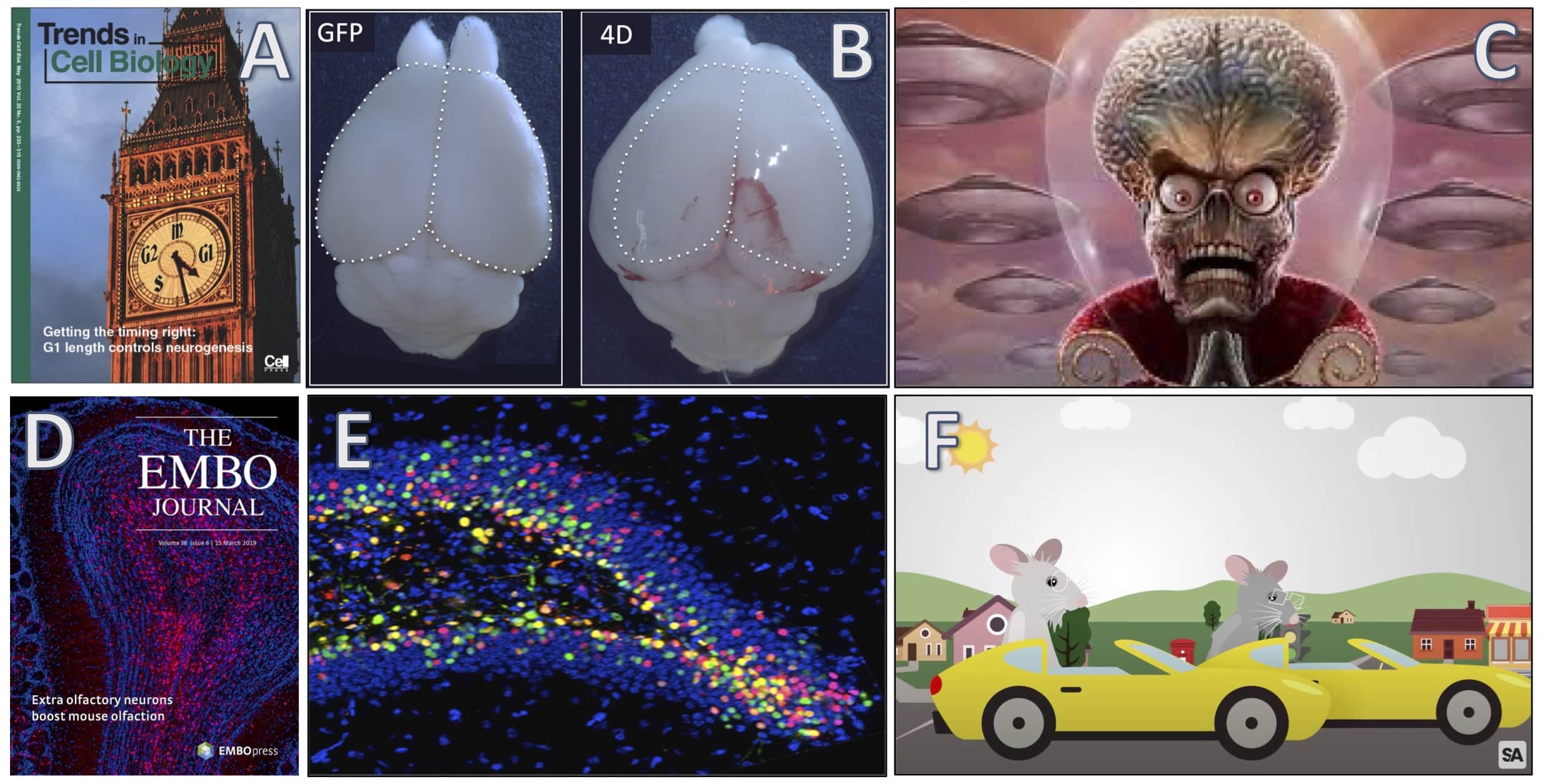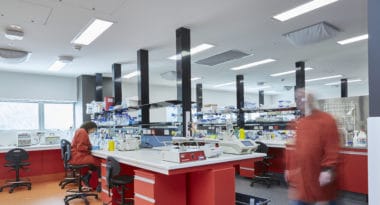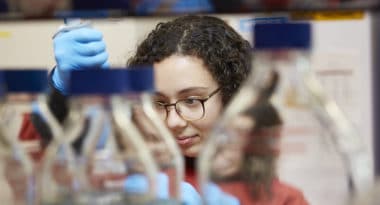The Calegari Group’s goal is to promote the expansion of endogenous neural stem cells (NSC) to improve the function of the mammalian brain.
It’s just a matter of Time: How to give the brain more neurons and protect Earth from Mars Attacks
NSC, like any other stem cell, can divide to generate two identical stem cells or differentiated progeny, such as neurons. We found that shortening the cell cycle of NSC induces them to expand, more than they usually do. As a result, they can generate more neurons. In turn, manipulating the Time of NSC allows us to generate mice with bigger brains, hence, smarter. Let’s us get into the details of this…
In the developing brain, a lengthening of the G1 phase of the cell cycle of NSC is necessary and sufficient to induce their switch from proliferation to differentiation (Salomoni & Calegari, 2010; Fig. 1A). Thus, all we need to do to expand NSC is to force them to cycle Fast & Furious. Christian did that by overexpressing Cdk4/cyclinD1 (4D) and, luckily for his PhD and my tenure evaluation, this worked quite well resulting in mice born with more neurons (Lange et al., 2009).
So far so good, we can generate mice with more neurons. But can we generate mice with folded brains and gyri like the human brain??? That was a project we could not resist, the problem was to find a student buying all that crap. We achieved the latter by recruiting Miki and making her an offer she could not refuse. The rest was downhill. Miki generated a dual-transgenic, tissue-specific, inducible and reversible 4D line, which resulted in a brainy mouse, which, needless to say, was called Miki Mouse (Nonaka et al. 2013). However, as big as these brains were, we couldn’t get any gyrus out of them (Fig. 1B). How did gyri emerge during evolution? Was Miki Mouse proof of Intelligent Design? To find this out, we teamed up with Victor’s group and expanded ferret NSC absent in mouse to finally get new gyri and folds (Nonaka et al., 2013).
Yet, the problem was to find editors, and creationists alike, to get the story published. We tried many Journals but they kept criticizing the lack of novelty given that “viruses to expand NSC were known to increase brain size and cognitive function in monkeys” (Wyatt et al. The Rise of the Planet of the Apes. Century Fox’s, 2011). So we changed our story by criticizing Wyatt’s report for the poor description of methods and noting that, in contrast to the aggressive monkeys, both Miki Mouse and Victor’s ferrets were well-behaved and never attacked any students. In turn, this suggested that gyrification correlates with megalomaniac behavior as fully supported by two hyper-aggressive and super-gyrified species: humans on this planet and Martians on our neighboring planet (Burton et al., Mars Attacks, 1996) (Fig. 1C). Victor and I could not allow those green midgets to invade us again, so we published a paper describing the Achilles’ heel of the Martians’ brain, and saved the world (Borrell & Calegari, 2014).
Development is interesting and fun but adult stem cells are interesting, fun, and useful (so everybody say…). Therefore, Benedetta used 4D to generate extra neurons in the adult brain by the overly complicated stereotaxic injection of tissue-specific, temporarily-controlled, tamoxifen-dependent ubb::GFPloxNLS-T2A-Cdk4-T2A-Ccnd1lox HIV-lentiviruses in C57BL/6J nestin::CreERT2 mice (…if you got that, you already deserved your PhD!). To cut it short, it worked (Artegiani et al., 2011) allowing Sara to improve the sense of smell (Bragado et al., 2019) (Fig. 1D) and Gaby to use a similar, but more colorful method (Fig. 1E) to make old mice remember how to feel young again (Berdugo et al., 2020). Since we like movies (you should have guessed by now), I made two videos of those two papers. Click on YouTube and enjoy (Sara’s; Gaby’s; Fig. 1F).

Figure 1 – 15 years of science, and counting A) Controlling the Time of NSC, our first cover choice was copyrighted, so we ended up with a plan B. B) Normal mouse brain and Super Miki Mouse after 4D doping. C) Victor and I prevent Mars Attacks, read our review to find out the Achille’s heel of the alien brain. D) More neurons in the brain make mice super-smellers. E) Dentate gyrus after viral co-injection. The experiment was completely useless but the picture great nonetheless. F) Mice with extra neurons are better drivers, check this out on YouTube.
Future
If you endured reading thus far, and could understand more than the average editor usually does, then you must be able to guess our future ambitions. Among these, is to expand NSC to rescue brain function in disease and, even more challenging, understand how can our 4D-neurons improve the computational performance the most sophisticated machine in the universe that we know: the brain.
Group Members

Research Themes
- Understanding endogenous neural stem cell progenitor subtypes and their role in development, evolution and adult neurogenesis
- Using neurogenesis to rescue brain deficits associated to aging or disease
More Publications
| Authors | Title | Published In |
|---|---|---|
Salomoni P, Calegari F. |
Cell cycle control of mammalian neural stem cells: putting a speed limit on G1. |
Trends Cell Biol. 2010 May;20(5):233-43. doi: 10.1016/j.tcb.2010.01.006. Epub 2010 Feb 12. PMID: 20153966. |
Lange C, Huttner WB, Calegari F. |
Cdk4/cyclinD1 overexpression in neural stem cells shortens G1, delays neurogenesis, and promotes the generation and expansion of basal progenitors. |
Cell Stem Cell. 2009 Sep 4;5(3):320-31. doi: 10.1016/j.stem.2009.05.026. PMID: 19733543. |
Nonaka-Kinoshita M, Reillo I, Artegiani B, Martínez-Martínez MÁ, Nelson M, Borrell V, Calegari F. |
Regulation of cerebral cortex size and folding by expansion of basal progenitors. |
EMBO J. 2013 Jul 3;32(13):1817-28. doi: 10.1038/emboj.2013.96. Epub 2013 Apr 26. PMID: 23624932; PMCID: PMC3926188. |
Borrell V, Calegari F. |
Mechanisms of brain evolution: regulation of neural progenitor cell diversity and cell cycle length. |
Neurosci Res. 2014 Sep;86:14-24. doi: 10.1016/j.neures.2014.04.004. Epub 2014 Apr 28. PMID: 24786671. |
Artegiani B, Lindemann D, Calegari F. |
Overexpression of cdk4 and cyclinD1 triggers greater expansion of neural stem cells in the adult mouse brain. |
J Exp Med. 2011 May 9;208(5):937-48. doi: 10.1084/jem.20102167. Epub 2011 Apr 11. PMID: 21482697; PMCID: PMC3092341. |
Bragado Alonso S, Reinert JK, Marichal N, Massalini S, Berninger B, Kuner T, Calegari F. |
An increase in neural stem cells and olfactory bulb adult neurogenesis improves discrimination of highly similar odorants. |
EMBO J. 2019 Mar 15;38(6):e98791. doi: 10.15252/embj.201798791. Epub 2019 Jan 14. PMID: 30643018; PMCID: PMC6418468. |
Berdugo-Vega G, Arias-Gil G, López-Fernández A, Artegiani B, Wasielewska JM, Lee CC, Lippert MT, Kempermann G, Takagaki K, Calegari F. |
Increasing neurogenesis refines hippocampal activity rejuvenating navigational learning strategies and contextual memory throughout life. |
Nat Commun. 2020 Jan 9;11(1):135. doi: 10.1038/s41467-019-14026-z. Erratum in: Nat Commun. 2020 Feb 25;11(1):1138. PMID: 31919362; PMCID: PMC6952376. |



